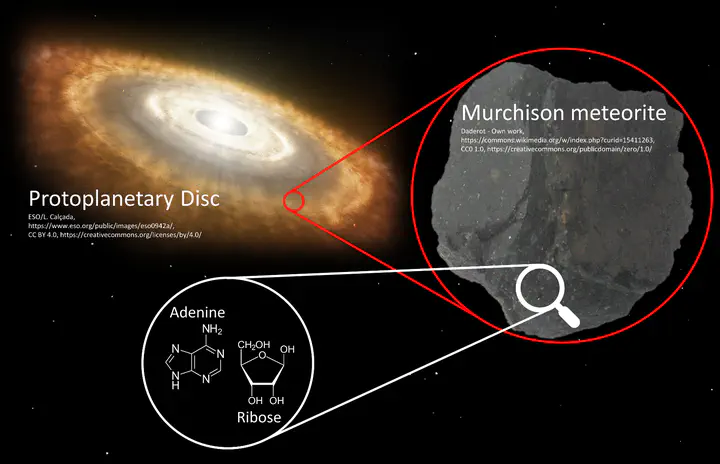Possible Ribose Synthesis in Carbonaceous Planetesimals
 Prebiotic molecules in carbonaceous chondrites - © CC BY 4.0
Prebiotic molecules in carbonaceous chondrites - © CC BY 4.0Abstract
The origin of life might be sparked by the polymerization of the first RNA molecules in Darwinian ponds during wet-dry cycles. The key life-building block ribose was found in carbonaceous chondrites. Its exogenous delivery onto the Hadean Earth could be a crucial step toward the emergence of the RNA world. Here, we investigate the formation of ribose through a simplified version of the formose reaction inside carbonaceous chondrite parent bodies. Following up on our previous studies regarding nucleobases with the same coupled physico-chemical model, we calculate the abundance of ribose within planetesimals of different sizes and heating histories. We perform laboratory experiments using catalysts present in carbonaceous chondrites to infer the yield of ribose among all pentoses (5Cs) forming during the formose reaction. These laboratory yields are used to tune our theoretical model that can only predict the total abundance of 5Cs. We found that the calculated abundances of ribose were similar to the ones measured in carbonaceous chondrites. We discuss the possibilities of chemical decomposition and preservation of ribose and derived constraints on time and location in planetesimals. In conclusion, the aqueous formose reaction might produce most of the ribose in carbonaceous chondrites. Together with our previous studies on nucleobases, we found that life-building blocks of the RNA world could be synthesized inside parent bodies and later delivered onto the early Earth.
Read more in my corresponding Twitter thread:
Do you know what the death of all dinosaurs 🦕 and the origins of life 🧬 might have in common? Carbonaceous chondrites, carbon-rich meteorites, 🌠 might have caused both. Skeptical? Hear me out 👇🧵 and read our w/@AstroBio_Ben freshly published paper https://t.co/x5XvmxmySR
— Klaus Paschek (@AstroBioKlaus) January 23, 2023
1/8 pic.twitter.com/QMi7WwApii